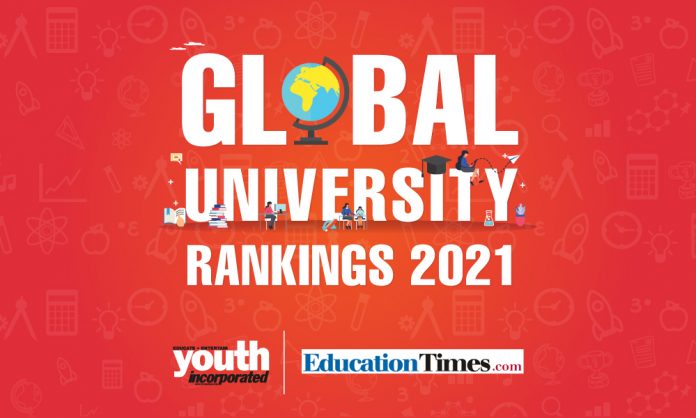Almost everyone has had to put their goals and life plans on hold for an entire year in 2020. Students especially had to face the brunt of the pandemic. With classes and the admission process coming to a halt, students and parents alike were perplexed for a very long time. Nevertheless, the pandemic hasn’t deterred the students from changing their study abroad plans. They are waiting to occupy the college campuses, classrooms, and cafeterias, bringing the universities back to life again. While this is undoubtedly a good thing, it is important to see how the universities across the world have fared in the challenging time of the pandemic and ensured the smooth imparting of education to its students.
Understanding this will help you make the right decision of choosing a university that best tailors your career goals. To make your decision-making process much faster and easier, Youth Incorporated, one of India’s youth magazines in association with Education Times has released its top 100 Global Undergraduate Rankings 2021 to assist students in making an informed decision of choosing not just the best but also the most suitable university for the purpose of higher studies. The rankings are categorized based on the location and course specialization of these universities.
Youth Incorporated’s Research Unit (YRU) contacted around 2550 institutes, and over 9600 recruiters to collect unbiased data about prime factors like value for money, student and recruiter satisfaction, infrastructure facilities, and pedagogy; factors that are primarily considered while finding the right university. Online survey forms were sent through emails to the institutes and recruiters to receive detailed information. Our team also approached the students and alumni of these universities, which has added more credibility to the rankings.
Based on the research that was conducted for several months and the data derived from this research thereafter, a list, ranking the top 100 undergraduate universities was formed. To give the readers a holistic view of how a particular institute has fared over the years, the ranking for this year was placed against our previously conducted annual rankings. We hope our in-depth survey will guide students in making the right choice yet again!
How Have The Universities Fared Compared To 2019 And 2020
After ranking second in 2020, Harvard University has once again gained its number 1 position in 2021; a rank it had maintained from 2016 until 2019. Taking second place is Stanford University, leaving its last year’s third position to be held by the University of Pennsylvania which stood first in 2020. Columbia University has made its way to the 4th position from the 6th position while Massachusetts Institute of Technology has retained its 5th position for the second consecutive year. Taking one step forward, Cornell University has shifted to the 6th position from the 7th which is now acquired by the University of Chicago which has slipped down from last year’s fourth rank. California Institute of Technology has flown from 2020’s 14th spot and landed on the 8th spot, entering the top 10 category. Both Princeton University and Yale University have glided one step down the ladder taking the 9th and 10th position respectively as opposed to their 8th and 9th rank in 2020. Since the London School of Economics and IE University have reached the 11th and 12th position in 2021, they are most likely to get placed in the top 10 global universities in the year 2022.
Just like every other year, the USA has gained a stronghold over the top 10 global universities as all the 10 universities this year are from the US. Thus, the Global University Rankings have proved that the USA is indeed the best place for students to pursue higher education.
The India Story
There have been no major changes in how India has fared in the Global University Rankings this year as compared to the last. However, it is essential to note that the Indian Institute of Technology Bombay has prominently secured the 17th position rising way above 2020’s 31st position making its way into the category of top 20 universities of the world. Speaking about the top 50 category, in addition to IIT Bombay, Indian Institute of Technology Delhi has taken the 29th position plunging from its 24th spot of the previous year. Just like in 2020, in 2021 too, the same 4 universities have found their place in the top 100 category with no new additions to the list. These four include the IIT Bombay, IIT Delhi, Indian Institute of Technology Kanpur standing on the 64th spot, and the University of Delhi on the 79th spot. While the University of Delhi has stayed on the same position since 2020, IIT Kanpur has descended from its 62nd position in 2020. Though an Indian institute has made its way into the top 20 category, with no new additions and the existing institutions sliding further down, the Indian institutes need to make some more efforts to reflect well in the next year’s rankings.
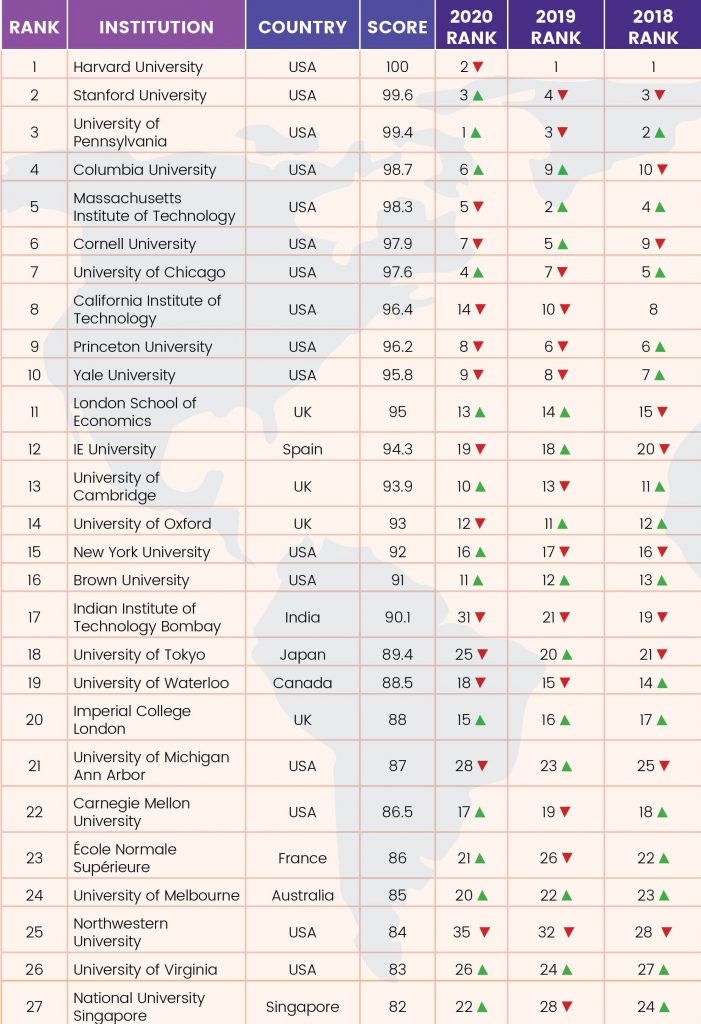
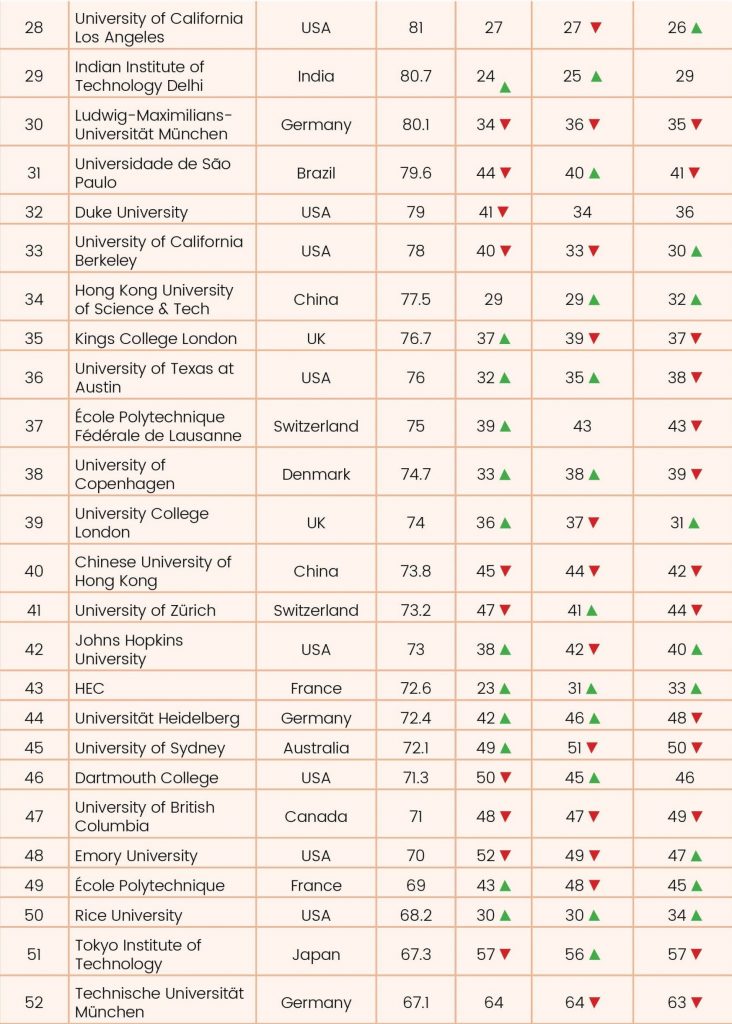
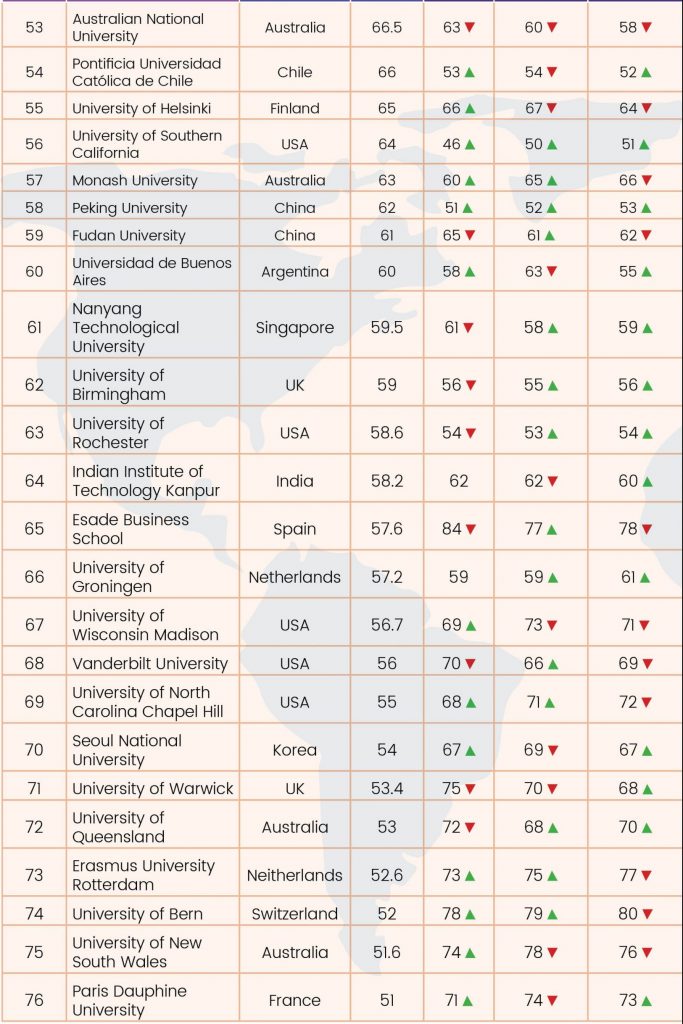
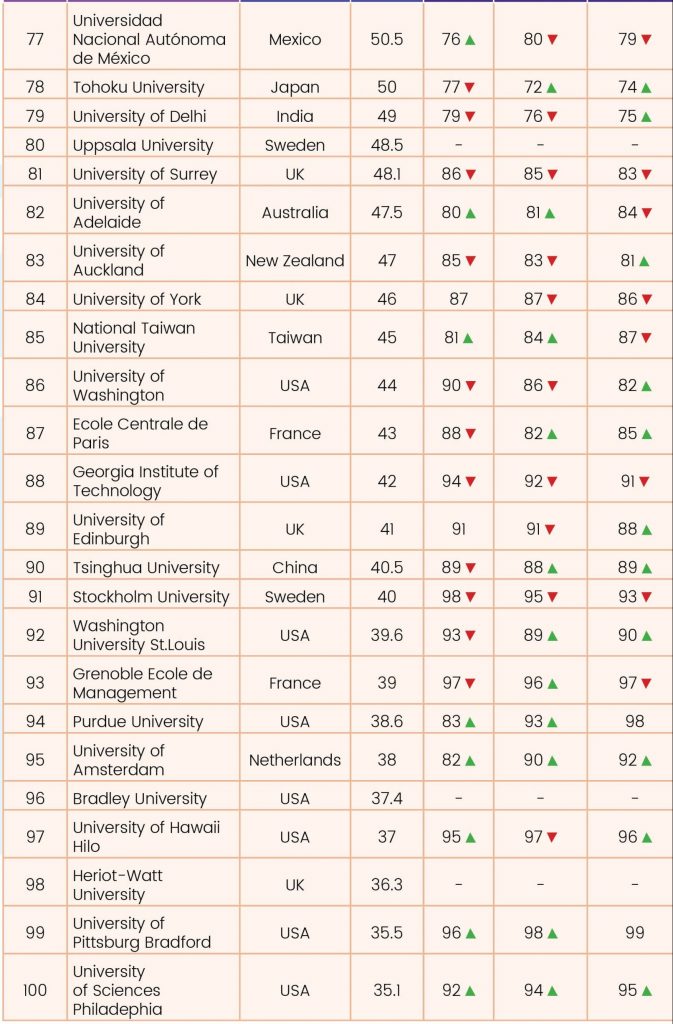
Ranking Methodology – Global Universities 2021
We chose institutes across the world after having discussions with thousands of students, recruiters and faculty. Youth Inc’s Research Unit (YRU) also studied domestic rankings in various countries to find the best institutes.
We sent survey links to 2550 institutes and provided them with unique codes so that they could submit their responses online. Institutes were also provided links to online surveys where their current students were asked to rate specific statements that pertained to the factors considered in this ranking. Institutes also sent separate survey links to their recruiters who in turn rated the institute’s career management cell as well as student employability.
Over 9600 additional recruiters were sent emails with a survey link. The recruiter list was prepared from the responses of the institutes and also included internationally well-known recruiters.
Below are the factors we considered and the overall weightage assigned to them:
- Careers, Recruitment and Industry viability of students – 55%
- Diversity and International Outlook – 10%
- Innovation – 10%
- Campus, Extracurricular activities, Exchange programmes – 15%
- Money, Student Satisfaction – 10%
Careers, Recruitment and Industry viability of students – 55%
This category significantly impacts the overall score of an institute since it is the most weighted factor. One of the most important criterions to select institutes is the student’s industry viability after graduation.
Recruiters were asked to list and rate the institutes that they were most likely to recruit from. They were asked the likelihood of recruiting again from the same institute and their satisfaction with the institute’s career cell. Recruiters rated students on various factors including analytical and problem solving skills, leadership potential, communication and interpersonal skills and so on.
Institutes, students and alumni were also asked about the availability and functioning of a career service cell on campus and how active such a service was. We also considered what percentage of students were actually placed, both domestically and internationally, through the institute’s career service cell. Students reported the availability and ease of obtaining internships.
Diversity and International Outlook – 10%
This category looks not only at diversity of faculty but also at diversity of students in class. The international outlook includes international students that are attracted and retained by the institute.
Institutes were asked to report the total number of students on campus and what percentage of the students were international and speak two or more languages. Gender diversity of the students was considered.
Institutes also reported the percentage of the faculty that were international, hold a doctorate degree and accredited with their own publishing material along with the gender diversity of the faculty.
Students and alumni were asked to rate the student and faculty diversity in their class.
Innovation – 10%
This category looks at the innovation used to construct and teach programmes and how faculty engage the students; an important factor in the overall perception of an institute.
We considered the different ways in which an institute constructs programmes. Institutes were asked to select from a list different teaching methodologies that we considered innovative – some of these included company visits, dual or multiple majors and course collaborations between different departments at the institute. Our list was made after surveying students across different campuses worldwide.
Students were asked to report how satisfied they are with faculty who use innovative ways to teach subjects.
Campus, Extracurricular activities, Exchange programmes – 15%
This category considers the support students receive on campus and the availability of extracurricular activities. The exchange programmes offered by the institute and how actively students are encouraged to opt for such programmes was also considered.
We asked the institutes to select the different types of assistance provided by the student office or a similar body on campus. Our initial list was selected after surveying students across different campuses worldwide.
Students and alumni reported if they were encouraged by the institute to participate in different extracurricular activities on campus.
Institutes were asked to report the percentage of students that opted for exchange programs. We also considered the exchange students present on the institute’s campus.
Money, Student Satisfaction – 10%
This category takes into account a critical part of college education today – finances. And more importantly, how satisfied a student is with the institute.
We considered students’ opinions on whether a particular institute was perceived as ‘value for money’. We also asked institutes to state the percentage of students who received some sort of funding from the institutes.
Students and alumni were asked to rate their institutes on various factors including attitude of staff and professors, location, course content and so on and institutes were asked to report the graduation rate of students enrolled and what percentage of students transfer out of the institution.
Scores
We calculated the standard deviation and standard scores (Z scores) so that we could combine and analyse the data with more accuracy and reliability. Below is a summary of the factors and the weightage given to each factor when we ranked the institutes. Each factor was made up of a set of questions. The total percentage attributed to that factor was based on the average score of the responses multiplied by the assigned weightage. The total scores were then sorted from highest to lowest. The institute with the highest score was ranked first.
| . | Institute | Cureent students | Alumni |
| Career Service | 3% | 1% | 1% |
| Diversity of Faculty | 3% | 1% | 1% |
| Diversity of Students | 3% | 1% | 1% |
| Innovation of Programs | 3% | 1% | 1% |
| Innovation in Teaching Methodologies | 3% | 1% | 1% |
| Campus Support | 3% | 1% | 1% |
| Extracurricular Activities | 3% | 1% | 1% |
| Exchange Programs | 3% | 1% | 1% |
| Value for Money | 3% | 1% | 1% |
| Student Satisfaction | 3% | 1% | 1% |
| 30% | 10% | 10% |
| Recruiters | |
| Recall of institute where to recruit from | 20% |
| Likelihood of recruiting from same institute again | 20% |
| Satisfaction with institute career cell | 10% |
| 50% |
Not just numbers
After we calculated the total computed scores for the institutes, we subjectively analyzed the data provided by the institutes, current students, and recruiters. If we found discrepancies in the satisfaction scores and the subjective descriptions, we omitted the data. This happened in the case of 9 institutes.
Missing Data
In a few rare occasions, some institutes did not supply data for all the questions in the survey. When data was missing which affected factors which were low-weighted such as value for money or campus support, we entered an estimate between the average and the lowest value reported by the institute.
By following such a practice we did not excessively penalise an institution with a ‘zero’ for data that it could not provide. At the same time, the institute was not rewarded.
Exclusion of Institutes
We required that at least 20% of the class size (of any specific institute) answer the student survey. Hence, some institutes were disqualified from our rankings because of rack of responses to the student and/or alumni survey.
Institutes that did not fill out the survey reports in time
11% of the institutes contacted did not complete the survey on time or did not respond. We used publicly available information on some of these institutes to include them in our rankings. We also contacted current students and recruiters of these institutes and compared the data we received with the data from institutes that participated in our survey.





















